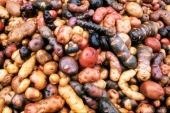









Order copies of my book, Dairy Farming: The Beautiful Way at
www.createspace.com
Help spread the word! Thanks!
struggle - hustle - soul - desire




Gilbert Fritz wrote:I am trying to figure out how many square feet of our community farm should be planted with each vegetable based on the number of people eating out of the garden. How to Grow More Vegetables has lots of very handy charts, which explain how many square feet to plant for so many pound os vegetables per person. And I intend to plant densely, as they recommend.
However, I will be using sheet mulch instead of double dug beds. Should I half the "beginner" expected yield, or, in other words, plant twice the square feet they recommend? Or could I get roughly a beginning biointensive yield out of sheet mulch beds?
Western Montana gardener and botanist in zone 6a according to 2012 zone update.
Gardening on lakebed sediments with 7 inch silty clay loam topsoil, 7 inch clay accumulation layer underneath, have added sand in places.




Iterations are fine, we don't have to be perfect
My 2nd Location:Florida HardinessZone:10 AHS:10 GDD:8500 Rainfall:2in/mth winter, 8in/mth summer, Soil:Sand pH8 Flat




S Bengi wrote:If you add 24inch of compost on top of the cardboard you effectively have 'bio-intensive' soil. I would up the carbon content with some biochar/twigs and some foliar spray/water kefir.
As for the yield, overseed and harvest micro-greens. To make your numbers look good, do mostly vegetables and add carbon+soil life/foliar spray to up your harvest.
Western Montana gardener and botanist in zone 6a according to 2012 zone update.
Gardening on lakebed sediments with 7 inch silty clay loam topsoil, 7 inch clay accumulation layer underneath, have added sand in places.






Iterations are fine, we don't have to be perfect
My 2nd Location:Florida HardinessZone:10 AHS:10 GDD:8500 Rainfall:2in/mth winter, 8in/mth summer, Soil:Sand pH8 Flat




 1
1




A build too cool to miss:Mike's GreenhouseA great example:Joseph's Garden
All the soil info you'll ever need:
Redhawk's excellent soil-building series









Western Montana gardener and botanist in zone 6a according to 2012 zone update.
Gardening on lakebed sediments with 7 inch silty clay loam topsoil, 7 inch clay accumulation layer underneath, have added sand in places.





List of Bryant RedHawk's Epic Soil Series Threads We love visitors, that's why we live in a secluded cabin deep in the woods. "Buzzard's Roost (Asnikiye Heca) Farm." Promoting permaculture to save our planet.

|
I'd appreciate it if you pronounced my name correctly. Pinhead, with a silent "H". Petite ad:
Homestead Pigs Course
https://permies.com/wiki/365748/Homestead-Pigs
|




